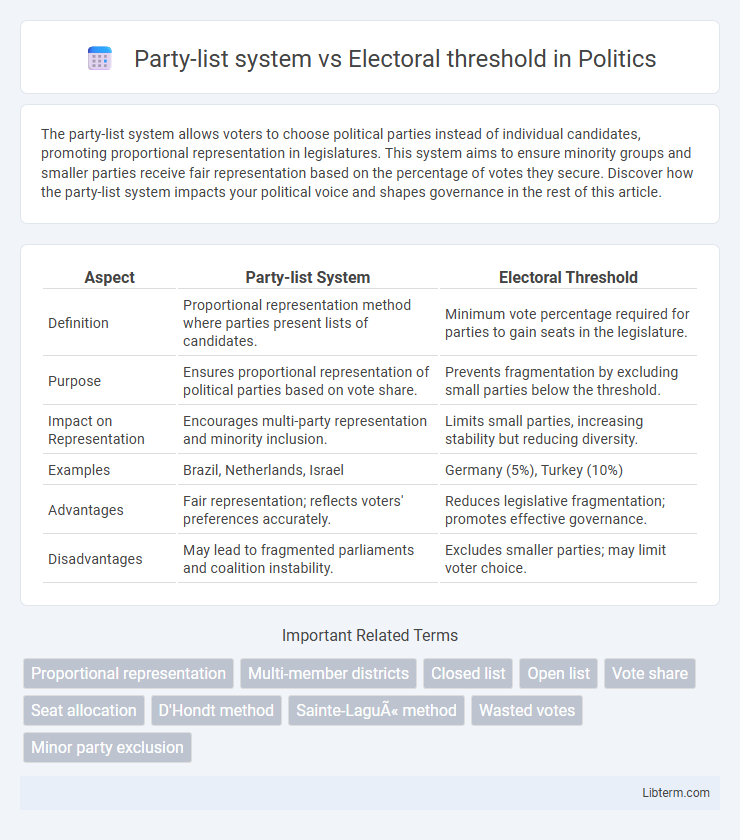The party-list system allows voters to choose political parties instead of individual candidates, promoting proportional representation in legislatures. This system aims to ensure minority groups and smaller parties receive fair representation based on the percentage of votes they secure. Discover how the party-list system impacts your political voice and shapes governance in the rest of this article.
Table of Comparison
| Aspect | Party-list System | Electoral Threshold |
|---|---|---|
| Definition | Proportional representation method where parties present lists of candidates. | Minimum vote percentage required for parties to gain seats in the legislature. |
| Purpose | Ensures proportional representation of political parties based on vote share. | Prevents fragmentation by excluding small parties below the threshold. |
| Impact on Representation | Encourages multi-party representation and minority inclusion. | Limits small parties, increasing stability but reducing diversity. |
| Examples | Brazil, Netherlands, Israel | Germany (5%), Turkey (10%) |
| Advantages | Fair representation; reflects voters' preferences accurately. | Reduces legislative fragmentation; promotes effective governance. |
| Disadvantages | May lead to fragmented parliaments and coalition instability. | Excludes smaller parties; may limit voter choice. |
Introduction to Party-list System
The party-list system allocates legislative seats based on the proportion of votes each party receives, promoting fair representation of diverse political groups. This system contrasts with the electoral threshold, which sets a minimum percentage of votes a party must obtain to gain seats, thereby limiting smaller parties' access to parliament. Understanding these mechanisms is crucial for analyzing how electoral systems influence political diversity and governance stability.
Definition of Electoral Threshold
The electoral threshold is the minimum percentage of votes a party must secure to gain representation in a party-list system, preventing fragmentation by excluding smaller parties with marginal support. In party-list proportional representation, this threshold ensures that only parties surpassing the set vote percentage, such as 5%, receive legislative seats. By enforcing an electoral threshold, electoral systems balance inclusivity with governability, promoting stable parliamentary majorities.
Historical Evolution of Electoral Systems
The party-list system, characterized by proportional representation, emerged in the early 20th century to enhance political inclusivity and minority representation. Electoral thresholds were introduced later as mechanisms to prevent parliamentary fragmentation by setting minimum vote percentages parties must obtain to win seats. This evolution reflects a balance between broad representation and governmental stability in electoral system design.
Key Principles of the Party-list Approach
The party-list system is designed to ensure proportional representation by allocating seats based on the total votes each party receives, reflecting the electorate's preferences more accurately than winner-takes-all methods. It emphasizes inclusivity and diversity by allowing smaller or marginalized groups to gain legislative seats without requiring a majority in any single district. Unlike the electoral threshold, which sets a minimum vote percentage for parties to enter parliament and potentially exclude smaller parties, the party-list system aims to balance fair representation with political pluralism.
Purpose and Impact of Electoral Thresholds
Electoral thresholds aim to prevent political fragmentation by requiring parties to secure a minimum percentage of votes to gain representation, promoting stable governance and policy continuity. This mechanism impacts party-list systems by limiting the number of small parties entering the legislature, ensuring that only those with significant voter support participate. Consequently, thresholds shape the party landscape, encouraging coalition-building and reducing the complexity of parliamentary decision-making.
Comparative Advantages: Representation and Fairness
The party-list system enhances proportional representation by allowing smaller parties to gain seats reflective of their actual vote share, promoting political diversity and inclusivity. In contrast, the electoral threshold filters out parties below a set vote percentage, preventing legislative fragmentation but potentially marginalizing minority voices. Balancing these mechanisms impacts fairness, with party-lists favoring comprehensive representation and thresholds ensuring governability and stability.
Challenges and Criticisms of Party-list Systems
Party-list systems often face criticism for enabling the proliferation of numerous small parties that can fragment the legislature and complicate governance. Electoral thresholds are implemented to mitigate this by requiring parties to secure a minimum percentage of votes to gain seats, but they can also marginalize minority groups and smaller political movements. These thresholds may lead to disproportional representation, reducing the inclusivity and diversity that party-list systems aim to promote.
Effects of Electoral Thresholds on Small Parties
Electoral thresholds significantly impact small parties by limiting their parliamentary representation, often excluding those that fail to meet the minimum vote percentage. In party-list systems, thresholds ranging from 3% to 5% can prevent vote fragmentation but also reduce political diversity and minority representation. Empirical studies show that higher thresholds correlate with decreased small party presence, consolidating power among larger parties and potentially altering coalition dynamics.
Global Case Studies: Party-list vs Thresholds
Party-list systems, such as those in Israel and South Africa, allow proportional representation where multiple parties gain seats based on vote share, promoting diverse political voices. Electoral thresholds, exemplified by Germany's 5% barrier and Turkey's stringent 10%, limit parliamentary entry to parties surpassing minimum vote percentages to prevent fragmentation and ensure governance stability. Case studies reveal that while lower thresholds encourage multiparty inclusiveness, higher thresholds foster political consolidation but may marginalize smaller or emerging parties.
Conclusion: Balancing Representation and Stability
The party-list system enhances proportional representation by allowing diverse political groups to gain legislative seats, fostering inclusivity and minority representation. Electoral thresholds, set at specific percentages, prevent excessive fragmentation by limiting entry to parties with significant voter support, promoting legislative stability. Striking a balance between low thresholds and broad representation ensures effective governance while reflecting the electorate's diversity.
Party-list system Infographic

 libterm.com
libterm.com